Mango Handling and Ripening Protocol
Mango_Handling_and_Ripening_Protocol
Mango_Handling_and_Ripening_Protocol
- No tags were found...
You also want an ePaper? Increase the reach of your titles
YUMPU automatically turns print PDFs into web optimized ePapers that Google loves.
<strong>Mango</strong> Receiving <strong>and</strong> Quality Assessment<br />
(QA)<br />
The primary goal for a QA team receiving mangos should be<br />
to ensure that the fruit was harvested at the correct maturity<br />
<strong>and</strong> will ripen to a ready to eat state that will satisfy<br />
consumers. Beyond this, each receiving company may have<br />
their own specifications that further serve the needs of the<br />
company <strong>and</strong> their customers.<br />
The <strong>Mango</strong> Maturity <strong>and</strong> Ripeness Guide (MMRG–see<br />
appendix) defines five maturity stages for the six most<br />
common commercial mango varieties sold in the United<br />
States. The MMRG includes internal flesh photos <strong>and</strong> color swatches, along with typical corresponding<br />
ranges for Soluble Solids Content (SSC) <strong>and</strong> Firmness.<br />
The MMRG is available free of charge from the NMB. While it is included in the appendix of this<br />
document, it is strongly recommended that you order physical copies of the MMRG for your QA<br />
team. The colors shown in the internal flesh photos <strong>and</strong> color swatches will look quite different<br />
depending on the monitor or printer used to output the charts, so it’s best to get the professionally<br />
printed <strong>and</strong> laminated version from the NMB.<br />
The mango quality research team at the University of Florida <strong>and</strong> the University of California-Davis<br />
developed the MMRG. In it, they recommend that at least 90% of the mangos tested in a shipment<br />
should fall in stage 2 or higher in order to be accepted.<br />
<strong>Mango</strong> Expectations at Receiving<br />
<strong>Mango</strong>s are harvested when mature (firm), but not ripe or ready to eat (soft)<br />
A mature mango will ripen normally with increasing percentage of soluble solids concentration<br />
(SSC) <strong>and</strong> decreasing starch <strong>and</strong> firmness (pounds force) to become flavorful <strong>and</strong> ready to eat<br />
At receiving, you can expect the mangos to be mature, but not necessarily ripe<br />
Maturity at harvest can be judged by a combination of factors, including flesh color, firmness,<br />
SSC, dry matter <strong>and</strong> fruit shoulder shape<br />
Maturity/Ripeness Indicators <strong>and</strong> Measurement<br />
Fruit Firmness decreases as the fruit matures on the tree <strong>and</strong><br />
continues to decrease during post-harvest ripening. Firmness<br />
should not be used as the only measure of maturity, but it can be a<br />
useful supplement to other indicators. See the MMRG for typical<br />
firmness ranges for each variety at each maturity stage.<br />
To measure mango firmness:<br />
Remove a thin patch of skin along the cheek side of the<br />
mango<br />
Be consistent in the amount of skin removed for each tested<br />
sample<br />
Place the mango on a firm surface for testing pressure<br />
Using a penetrometer with an 8 mm (5/16”) tip, measure the fruit firmness<br />
Repeat the process on the other cheek <strong>and</strong> record the average<br />
Avoid hitting the seed during the test<br />
A drill-press style penetrometer is more accurate <strong>and</strong> consistent than a h<strong>and</strong>-held version<br />
<strong>Mango</strong> <strong>H<strong>and</strong>ling</strong> <strong>and</strong> <strong>Ripening</strong> <strong>Protocol</strong> 4


